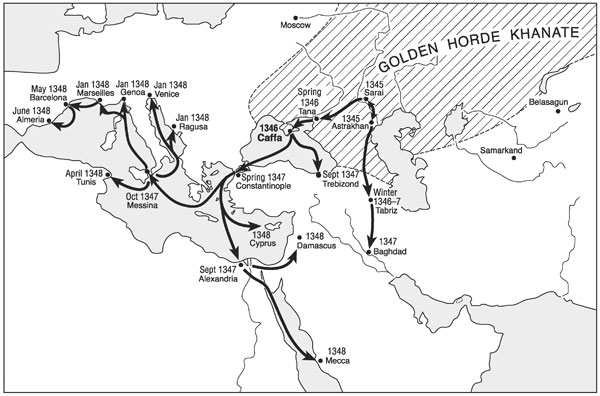Volume 8, Number 9—September 2002
Historical Review
Biological Warfare at the 1346 Siege of Caffa
Figure 1
References
- Norris J. East or West? The geographic origin of the Black Death. Bull Hist Med. 1977;51:1–24.PubMedGoogle Scholar
- Henschel AW. Document zur Geschichte des schwarzen Todes. Archives für die gesammte Medizin 1842;2:26–59.
- Tononi AG. La Peste Dell’ Anno 1348. Giornale Ligustico de Archeologia. Storia e Letteratura. 1884;11:139–52.
- Horrox R, ed. The Black Death. Manchester: Manchester University Press; 1994. p. 14–26.
- Hecker JFC. The epidemics of the Middle Ages. London: Sydenham Society; 1844.
- Pollitzer R. Plague. Geneva: World Health Organization; 1954.
- Benenson AS. Control of communicable diseases manual. Washington: American Public Health Association; 1995.
- Bottone EJ. Francisella tularensis, Pasteurella, and Yersinia pestis. In: Gorbach SL, Bartlett JG, Blacklow NR, editors. Infectious diseases. Philadelphia: WB Saunders; 1998: p. 1819–24.
- Dennis DT, Gratz N, Poland JD, Tikhomirov E. Plague Manual: Epidemiology, distribution, surveillance and control. Geneva: World Health Organization; 1999.
- Boyce JM. Yersinia species. In: Mandell GL, Douglas RG Jr, Bennett JE, editors. Principles and practice of infectious disease. 2 ed. New York: John Wiley and Sons; 1985. p.1296–301.
- Dols MW. The Black Death in the Middle East. Princeton (NJ): Princeton University Press; 1977.
- Gasquet FA. The great pestilence (A. D. 1348–9), now commonly known as the Black Death. London: Simpkin Marshall, Hamilton, Kent & Co.; 1893.
- Bartsocas CS. Two fourteenth century Greek descriptions of the "Black Death.”. J Hist Med Allied Sci. 1966;21:394–400. DOIGoogle Scholar
- Vasiliev AA. The Goths in the Crimea. Cambridge (MA): Mediaeval Academy of America; 1936.
- Gardiner R. The Age of the galley: Mediterranean oared vessels since pre-classical times. Annapolis (MD): Naval Institute Press; 1995.
- Fayle CE. A short history of the world's shipping industry. London: George Allen & Unwin; 1933.
- Lewis AR, Runyan TJ. European naval and maritime history, 300–1500. Bloomington (IN): Indiana University Press; 1985.
- Grousset R. The empire of the steppes: a history of Central Asia. New Brunswick (NJ): Rutgers University Press; 1970.
- Obolensky D. The Byzantine commonwealth: Eastern Europe, 500–1453. London: Weidenfeld and Nicolson; 1971.
- Howorth HH. History of the Mongols, from the 9th to the 19th century. New York: Burt Franklin; 1880.
- Wheelis M. Biological warfare before 1914. In: Geissler E, Moon JEvC, editors. Biological and toxin weapons: research, development and use from the Middle Ages to1945. London: Oxford University Press; 1999. p. 8–34.
- Slack P. Responses to plague in early modern Europe: the implications of public health. In: Mack A, editor. Time of plague; the history and social consequences of lethal epidemic disease. New York: New York University Press; 1991. p. 111–31.
- Centers for Disease Control and Prevention. Prevention of plague: recommendations of the Advisory Committee on Immunization Practices (ACIP). MMWR Morb Mortal Wkly Rep. 1996;45:1–15.PubMedGoogle Scholar
- Hadingham E. Ready, aim, fire! A risky experiment reveals how medieval engines of war brought down castle walls. Smithsonian. 1975;30:78–87.
- Payne-Gallwey R. A summary of the history, construction and effects in warfare of the projectile-throwing engines of the ancients, with a treatise on the structure, power and management of Turkish and other oriental bows of medieval and later times. London: Longmans, Green and Co.; 1907.
- Twigg G. The Black Death: a biological reappraisal. London: Batsford Academic and Educational; 1984.
- Barnett SA. The rat: a study in behavior. Chicago: University of Chicago; 2000.
- Harris SH. Factories of death: Japanese biological warfare 1932–45 and the American cover-up. New York: Routledge; 1994.
- Alibek K, Handelman S. Biohazard: The chilling true story of the largest covert biological weapons program in the world—told from the inside by the man who ran it. New York: Random House; 1999.
- Inglesby TV, Dennis DT, Henderson DA, Bartlett JG, Ascher MS, Eitzen E, Plague as a biological weapon: medical and public health management. JAMA. 2000;283:2281–90. DOIPubMedGoogle Scholar
1Technically trebuchets, not catapults. Catapults hurl objects by the release of tension on twisted cordage; they are not capable of hurling loads over a few dozen kilograms. Trebuchets are counter-weight-driven hurling machines, very effective for throwing ammunition weighing a hundred kilos or more (22).
2Medieval society lacked a coherent theory of disease causation. Three notions coexisted in a somewhat contradictory mixture: 1) disease was a divine punishment for individual or collective transgression; 2) disease was the result of "miasma," or the stench of decay; and 3) disease was the result of person-to-person contagion (23).
Page created: July 16, 2010
Page updated: July 16, 2010
Page reviewed: July 16, 2010
The conclusions, findings, and opinions expressed by authors contributing to this journal do not necessarily reflect the official position of the U.S. Department of Health and Human Services, the Public Health Service, the Centers for Disease Control and Prevention, or the authors' affiliated institutions. Use of trade names is for identification only and does not imply endorsement by any of the groups named above.
